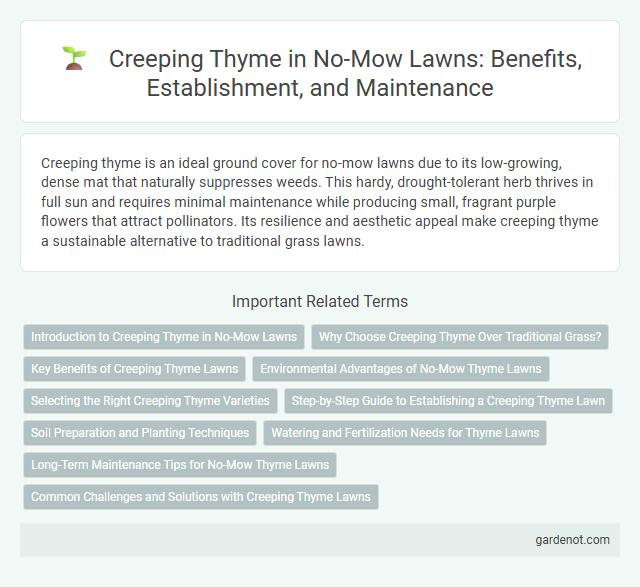Creeping thyme is an ideal ground cover for no-mow lawns due to its low-growing, dense mat that naturally suppresses weeds. This hardy, drought-tolerant herb thrives in full sun and requires minimal maintenance while producing small, fragrant purple flowers that attract pollinators. Its resilience and aesthetic appeal make creeping thyme a sustainable alternative to traditional grass lawns.
Introduction to Creeping Thyme in No-Mow Lawns
Creeping thyme is a low-growing, drought-tolerant ground cover ideal for no-mow lawns due to its dense mat formation and ability to suppress weeds. This perennial herb thrives in well-drained soil and full sun, offering vibrant purple blooms that attract pollinators while requiring minimal maintenance. Its resilience to foot traffic and resistance to pests make creeping thyme an eco-friendly, sustainable alternative to traditional grass lawns.
Why Choose Creeping Thyme Over Traditional Grass?
Creeping thyme requires significantly less water and maintenance compared to traditional grass, making it an eco-friendly choice for sustainable landscaping. Its ability to thrive in poor soil conditions and resist drought reduces the need for fertilizers and irrigation. This low-growing ground cover also attracts pollinators like bees, enhancing biodiversity while providing a durable, fragrant, and visually appealing alternative to conventional lawns.
Key Benefits of Creeping Thyme Lawns
Creeping thyme lawns offer drought resistance and low maintenance, thriving with minimal watering and mowing needs. Their dense matting effectively suppresses weeds while providing a fragrant, pollinator-friendly ground cover that enhances biodiversity. The resilient nature of creeping thyme makes it ideal for areas with foot traffic, ensuring durability without compromising aesthetic appeal.
Environmental Advantages of No-Mow Thyme Lawns
Creeping thyme as a no-mow lawn alternative significantly enhances biodiversity by providing nectar and habitat for pollinators like bees and butterflies. Its deep root systems improve soil health and reduce erosion, promoting natural water retention and minimizing runoff. This low-maintenance ground cover also reduces carbon emissions by eliminating the need for gas-powered lawn equipment.
Selecting the Right Creeping Thyme Varieties
Choosing the right creeping thyme variety is essential for a thriving no-mow lawn, with popular options like Thymus serpyllum 'Elfin' and Thymus praecox 'Arctic Snow' offering drought tolerance and vibrant blooms. Varieties such as Thymus coccineus provide excellent ground cover with attractive red flowers, while Thymus pseudolanuginosus is favored for its dense, woolly texture suited to foot traffic. Evaluating local climate conditions and soil type ensures optimal growth and durability for a sustainable, low-maintenance lawn alternative.
Step-by-Step Guide to Establishing a Creeping Thyme Lawn
Prepare the soil by removing existing grass and weeds, then loosen the top 2-3 inches for optimal root growth of creeping thyme. Space seeds or plugs evenly, ensuring good soil contact, and water consistently to keep the area moist during establishment. After 6-8 weeks, gradually reduce watering frequency as creeping thyme matures, creating a dense, low-maintenance no-mow lawn.
Soil Preparation and Planting Techniques
Creeping thyme thrives in well-drained, sandy or loamy soil with a neutral to slightly alkaline pH, making soil preparation crucial for optimal growth. Before planting, clear the area of weeds, till the soil to a depth of 4-6 inches, and mix in organic compost to enhance soil fertility and drainage. Space the creeping thyme plants 12 to 18 inches apart to ensure proper air circulation and encourage vigorous ground cover.
Watering and Fertilization Needs for Thyme Lawns
Creeping thyme lawns require minimal watering, thriving best with occasional deep watering once established to maintain drought tolerance and prevent root rot. Fertilization needs are low; applying a balanced, slow-release fertilizer in early spring supports healthy growth without encouraging excessive leafiness or reducing aromatic oil production. Over-fertilizing can weaken thyme's natural resilience and diminish its drought resistance, making water-efficient practices essential for sustainable thyme lawn care.
Long-Term Maintenance Tips for No-Mow Thyme Lawns
Creeping thyme thrives in no-mow lawns due to its low growth habit and drought resistance, requiring minimal watering and no frequent mowing. Regularly trimming flowering stems after bloom prevents legginess and encourages denser ground cover, enhancing weed suppression over time. Applying a balanced, slow-release fertilizer in early spring supports healthy growth and vibrant foliage without promoting excessive vertical height.
Common Challenges and Solutions with Creeping Thyme Lawns
Creeping thyme lawns often face challenges such as slow initial establishment and vulnerability to heavy foot traffic, which can cause thinning and bare spots. Effective solutions include planting during optimal conditions in early spring or fall, ensuring well-drained soil with full sun exposure, and implementing occasional overseeding to maintain dense coverage. Incorporating organic mulch and limiting traffic during establishment phases enhances durability and promotes healthy, resilient growth.
Creeping thyme Infographic

 gardenot.com
gardenot.com